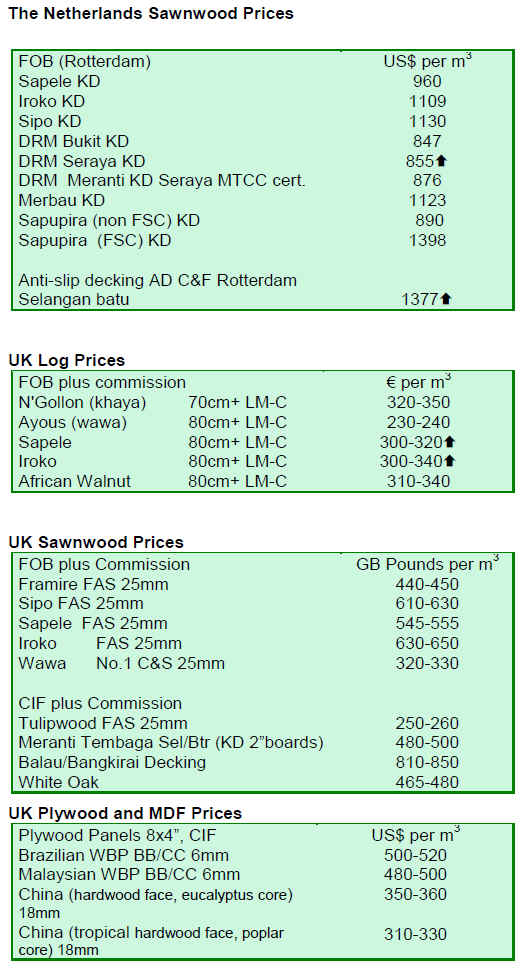|
Report
from
Europe, the UK
and
Russia
Re-stocking plywood
The market for tropical hardwood plywood in Europe is
now winding down for the Christmas break which is likely
to be extended this year. However there has been some
forward buying in recent weeks as importers have been
filling gaps in stocks in preparation for the New Year.
Although very few people are expecting a dramatic
turnaround in demand during the first half of 2010, there is
mounting concern that temporary supply problems may
arise due to short-falls in landed stocks.
For much of 2009, European importers focused on
winding down stock levels in the face of weak underlying
consumption and uncertain economic conditions. For the
first six months of the year, the large European plywood
importers shifted away from bulk to container shipments
as rates for the latter were extremely low and as importers
were looking increasingly to buy smaller mixed batches.
However since the middle of 2009 freight rates have risen
consistently as shipping lines reacted to the decline in
trade by decommissioning a large number of vessels. Now
much of the remaining capacity is overbooked. A 3-4
week gap between placing of forward orders and shipment
to Europe has opened up making it more difficult for
importers to fulfil short-term obligations. Importers may
therefore be forced to build and carry more stock during
the early part of 2010.
Shifting to combi-products
This year the UK market has shifted increasingly away
from tropical-hardwood- throughout plywood in favour of
products with a pine or poplar core. While bearing a
passing resemblance to tropical hardwood plywood, the
combi-product is much cheaper and 每 being widely
offered from CE2+ certified mills - is generally regarded
as providing adequate performance for a range of fairly
utilitarian tasks in the UK.
Government green procurement policy in the UK has also
tended to favour increased use of combi-product. Until
recently there was particular interest in FSC Mixed
products manufactured in Malaysia from an FSC-certified
New Zealand radiata pine core and an MTCS-certified
tropical hardwood face. However with the recent
endorsement of MTCS by PEFC, more of this product is
expected to be supplied with the PEFC logo.
The first shipment of PEFC-certified Malaysian combiplywood,
of around 10,000 cubic metres, is expected to be
shipped to the UK in January. This is believed to be priced
at around US$400/cu.m CIF UK for 18 mm product,
significantly cheaper than the uncertified tropicalthroughout
plywood.
Manufacturers of alternative plywood products are also
trying to exploit the rising interest in PEFC and FSC
certified product in the UK plywood market. Weyerhauser
has been particularly active marketing ※tropical
replacement panel§.
This is available FSC-certified and manufactured from
Uruguayan plantation-grown eucalyptus. It bears a passing
resemblance to tropical plywood, is supplied by a CE2+
certified mill and prices are very competitive. On the other
hand, according to one major UK importer, the product is
derived from smaller-diameter logs, cannot match the
performance of tropical hardwood plywood and the
volumes available are not yet large.
Drift away from Chinese plywood
The UK plywood market*s dependence on China has
tended to decline this year. One large UK importer notes
that ※three quarters of Chinese manufacturers that were
formerly manufacturing plywood are no longer involved in
the plywood trade 每 most UK importers are now only
dealing with a small number of larger better performing
mills§.
This importer also noted that, due to lack of capital and
credit, many Chinese mills are now asking for a 25%
deposit up-front in order to purchase raw materials. This is
a major disincentive to European importers buying from
China.
Caution in market for tropical hardwood lumber
European tropical hardwood lumber importers have
maintained a cautious approach to forward orders
throughout the final quarter of the year. This is despite the
combination of a strong euro, the widespread belief that
European stocks are now quite low and signs that FOB
prices for key products in both Africa and Asia are rising
on the back of tight log supplies.
There is still great uncertainty over the likely level of
European tropical hardwood consumption next year. Few
importers are willing to speculate on market conditions 3
to 4 months in the future 每 which is the current lead time
between ordering and delivery for African sawnwood.
Lack of credit and cash-flow continue to be problems for
many importers. As a result forward orders in recent
weeks have concentrated on small mixed batches to fill
gaps in stocks as they emerge.
Although some of the larger European importers engaged
in the tropical hardwood trade report reasonable levels of
trade this year 每 particularly those with a varied stock base
and capable of delivering over a wide distance at short
notice 每 most companies reckon that sales will have
slumped by double-digit percentages in 2009.
Margins have also tightened as intense competition
between importers has put downward pressure on
European wholesale prices at a time when CIF prices have
been rising. There continue to be reports of importers
being forced to sell tropical hardwood lumber at below
replacement price.
Decking orders
At this time of year, importers would normally be placing
significant orders for garden decking products for the
spring season. However orders are well down this year as
the large merchants and retailers have been very reluctant
to indicate their needs for 2010.
Window frame market
The German window frame market is one of the few
bright spots in a generally gloomy picture. This sector is
creating consistent demand for Malaysian and Indonesian
Meranti window scantlings, but relatively high prices for
the Asian hardwoods and limited availability mean that the
actual volume of trade is now low.

|